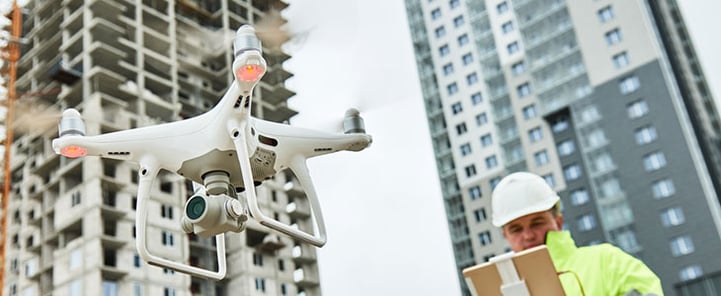Streamline your tender management and receive subcontractor and supplier quotes directly inside Cubit Select. Managing y...
Streamline your tender management and receive subcontractor and supplier quotes directly inside Cubit Select. Managing y...
The commercial building industry has experienced unprecedented growth in recent years. It’s also experienced unprecedented change. Its transformation is mainly owed to technological advancements and a shift in project management techniques.
Even though it’s hard to predict the future of the built environment, there are several standout trends to watch in years to come. The following are 10 of the most profound commercial building trends that tradespeople and project managers should look forward to this year.

According to PrefabAus, the Australian commercial building industry in 2018 will be characterised by an increase in offsite construction.
This incorporates both prefabrication and modular construction, both of which have experienced a renewed interest in recent years. As a project manager, incorporating aspects of offsite construction in your projects can assist in meeting timelines and budgets.
Offsite construction guarantees a condensed schedule, allowing you to complete projects at speed and scale. Unlike traditional onsite construction, off-site construction is conducted in a controlled environment with no weather-related and similar delays. The assembly line-esque environment also makes construction safer, since there are no fall hazards that typically exist in traditional construction sites.

Most upcoming commercial buildings are striving to incorporate aspects of sustainable construction. According to IBIS World, green building will continue being a major trend this year. Mass timber projects are also likely to gain prominence in 2018, and the commercial building industry will witness an unprecedented increase in recycling construction.
There is also likely to be an increase in the use of waste from renovation and demolition projects in upcoming commercial buildings. In the past year for instance, waste that would have otherwise ended up in landfills is increasingly being diverted to ongoing projects. Using this waste as an aggregate base for building foundations can help you make significant cost savings.

The resilience of commercial buildings is also likely to be a major talking point this year due to an increase in natural disasters. As a building professional, you need to focus on projects that not only have a minimal environmental impact, but can also withstand natural disasters.
The recent spike in natural calamities across the world poses a great risk to the built environment. For this reason, property developers are increasingly seeking to build commercial buildings that can either adapt to or withstand these disasters.

The traditional process of ‘design, bid, and build’ is long gone. Collaborative efforts are trending, with these approaches likely to gain more ground this year. Collaborative approaches to commercial construction include public-private partnerships.
Construction experts believe that 2018 will witness more project team collaborations that include architects, engineers, project managers, financers, and government institutions. These collaborative processes typically consolidate the design and construction phases under one contract.
This allows you to enter into a single contract with the project owner, and other stakeholders in a bid to determine project costs, goals, and risks collectively. Such efforts will ultimately allow you to complete projects within the required timeframe.
Efficient estimating software will be critical for construction professionals to take advantage of this process.

Labour shortages are a concern for the construction market in Australia, with a lack of skilled labourers being a major challenge for many job site managers.
With continued infrastructure development and inadequate technical training, project managers are struggling to find skilled tradesmen. The dwindling labour pool could also be attributed to more young people choosing a different career path from building and construction. This trend will continue in 2018 and beyond. You can navigate this challenge by offering on-site training to current employees to boost their skillset.

In 2017, there was a remarkable incorporation of the Internet of Things in commercial building projects. IoT encapsulates elements such as employee and equipment tracking, construction tech landscape, wearables, and drones in construction.
These technologies not only enhance job site efficiency, but also the safety of your workers. Combining the benefits of the Internet of Things and business intelligence can enable you to make quick and intelligent decisions.
Technologies such as wearables help you to monitor workers at the job site, thus ensuring that they are protected from hazards and potential injuries. On the other hand, equipment sensors enable you to know whether or not your machines are in need of repair. Such advancements are likely to gain more traction this year.

The incorporation of augmented and virtual reality technology in the construction of commercial buildings gained prominence in 2017. Its ability to enhance collaboration among project stakeholders before actual construction begins is unmatched.
With VR and AR tech, your team can easily detect errors in the design phase. This way, you avoid costly mistakes that might jeopardise your project.
Using the technology, you can easily monitor job site conditions without exposing employees to safety hazards. Despite its potential, VR/AR technology is somewhat costly due to high implementation expenses. Therefore, it can only be used on large projects.

In the past few years, the commercial construction industry has faced a lot of scrutiny resulting from safety violations. The building boom has come with its own fair share of incidents.
It is expected that this year, more attention will be paid to job site safety by law enforcement agencies. Authorities are likely to enhance efforts aimed at prosecuting cases related to job site safety violations. As a job site manager, you are under more pressure to ensure job site safety.

Prior to the financial recession which hit the construction industry hard, lending institutions were more receptive to the idea of funding construction projects with minimal collateral.
Things have changed in recent years due to a sporadic increase in material costs. It’s expected that these costs will remain high despite limited financial options.
To keep costs down and complete your projects within the required timeframe, consider options such as public-private partnerships that guarantee a steady cash flow. Bundling your project with others can also enable you to obtain better pricing on materials.

Adaptive reuse is another major trend that has characterised the commercial building industry, and which is likely to endure this year. Rather than tear down a structure, owners are increasingly opting to restore them for a different purpose.
This not only enhances economic development but also ensures urban revitalisation. Simply put, adaptive reuse gives abandoned buildings a new lease of life.
These projects are particularly popular in urban areas where amenities such as old factories, warehouses, and even train stations are converted into office blocks and other facilities. As a job site professional, you need to reinvent yourself and boost your skill set to have the ability to be part of the reconfiguration of such facilities.
The dynamic nature of the commercial building industry highlights why project managers and tradespeople need to continuously learn about new trends. Keeping up with these and other construction trends will provide a competitive advantage in the industry. With the emergence of new trends, the future landscape of the industry is likely to change significantly.
To discover how your business can prepare for the future with our market-leading estimating software, get a free 14-day Cubit trial today.
There’s no doubt technology has changed - and continues to change - our lives an...
For construction companies today, staying up to date with digital advances is cr...
The world has changed and continues to change rapidly around us. Faced with this...


Ⓒ 2024 Buildsoft. All rights reserved